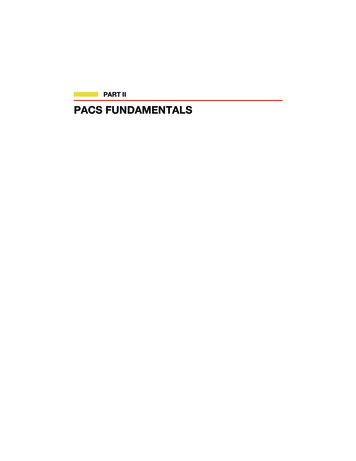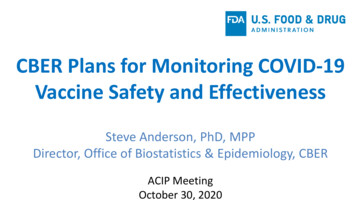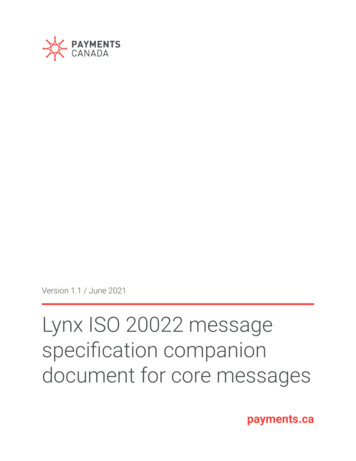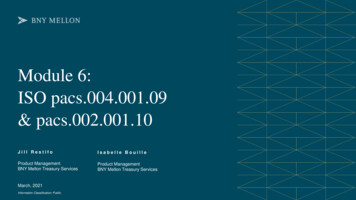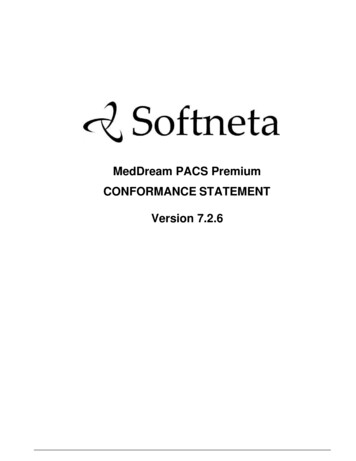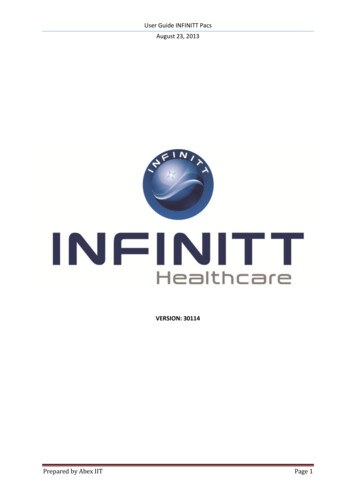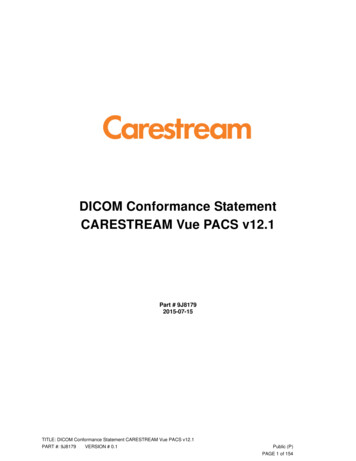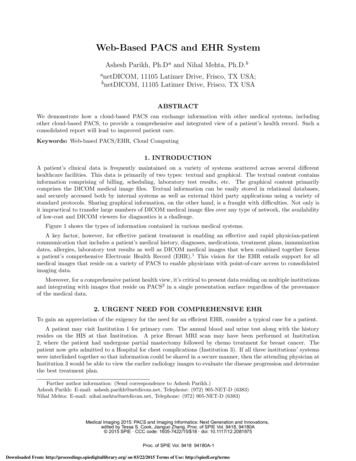
Transcription
Web-Based PACS and EHR SystemAshesh Parikh, Ph.Da and Nihal Mehta, Ph.D.ba netDICOM,b netDICOM,11105 Latimer Drive, Frisco, TX USA;11105 Latimer Drive, Frisco, TX USAABSTRACTWe demonstrate how a cloud-based PACS can exchange information with other medical systems, includingother cloud-based PACS, to provide a comprehensive and integrated view of a patient’s health record. Such aconsolidated report will lead to improved patient care.Keywords: Web-based PACS/EHR, Cloud Computing1. INTRODUCTIONA patient’s clinical data is frequently maintained on a variety of systems scattered across several differenthealthcare facilities. This data is primarily of two types: textual and graphical. The textual content containsinformation comprising of billing, scheduling, laboratory test results, etc. The graphical content primarilycomprises the DICOM medical image files. Textual information can be easily stored in relational databases,and securely accessed both by internal systems as well as external third party applications using a variety ofstandard protocols. Sharing graphical information, on the other hand, is a fraught with difficulties. Not only isit impractical to transfer large numbers of DICOM medical image files over any type of network, the availabilityof low-cost and DICOM viewers for diagnostics is a challenge.Figure 1 shows the types of information contained in various medical systems.A key factor, however, for effective patient treatment is enabling an effective and rapid physician-patientcommunication that includes a patient’s medical history, diagnoses, medications, treatment plans, immunizationdates, allergies, laboratory test results as well as DICOM medical images that when combined together formsa patient’s comprehensive Electronic Health Record (EHR).1 This vision for the EHR entails support for allmedical images that reside on a variety of PACS to enable physicians with point-of-care access to consolidatedimaging data.Moreover, for a comprehensive patient health view, it’s critical to present data residing on multiple institutionsand integrating with images that reside on PACS2 in a single presentation surface regardless of the provenanceof the medical data.2. URGENT NEED FOR COMPREHENSIVE EHRTo gain an appreciation of the exigency for the need for an efficient EHR, consider a typical case for a patient.A patient may visit Institution 1 for primary care. The annual blood and urine test along with the historyresides on the HIS at that Institution. A prior Breast MRI scan may have been performed at Institution2, where the patient had undergone partial mastectomy followed by chemo treatment for breast cancer. Thepatient now gets admitted to a Hospital for chest complications (Institution 3). If all three institutions’ systemswere interlinked together so that information could be shared in a secure manner, then the attending physician atInstitution 3 would be able to view the earlier radiology images to evaluate the disease progression and determinethe best treatment plan.Further author information: (Send correspondence to Ashesh Parikh.)Ashesh Parikh: E-mail: ashesh.parikh@netdicom.net, Telephone: (972) 905-NET-D (6383)Nihal Mehta: E-mail: nihal.mehta@netdicom.net, Telephone: (972) 905-NET-D (6383)Medical Imaging 2015: PACS and Imaging Informatics: Next Generation and Innovations,edited by Tessa S. Cook, Jianguo Zhang, Proc. of SPIE Vol. 9418, 94180A 2015 SPIE · CCC code: 1605-7422/15/ 18 · doi: 10.1117/12.2081975Proc. of SPIE Vol. 9418 94180A-1Downloaded From: http://proceedings.spiedigitallibrary.org/ on 03/22/2015 Terms of Use: http://spiedl.org/terms
RIS - Radiology- specificPACSRepository of ImagesHISPatient scheduling,billing, financials, reports,worklists, labs, and manyother items that recordthe complete patient paththrough a healthcaresystemImage -based (light ontext)Text -basedFigure 1. Schematic showing types of clinical information in various systemsRIS -1PACS-1PACS -2PACS -3Blood ReportUrine SampleMRI- Breastbilateral Tg11/2008w /outPET CTTumorWhole Body@ 8/2008HIS -1Contrast@ 1112008Figure 2. Components of Patient’s EHR.In the absence of immediate availability of the patient’s history, the physician instead ordered PET CT TumorWhole Body followed by MRI Bilateral T without Contrast. These additional tests could have been avoidedwith a comprehensive EHR.Figure 2 illustrates the above scenario. In this example, the patient medical data resides on several systems,such as Health Information Systems (HIS), Radiology Information Systems (RIS) while the actual radiologyimages resides on the organization’s PACS.3 Many of these systems are proprietary and are incompatible inseveral regards and unable to communicate or exchange information with each other using standards basedcommunications.Proc. of SPIE Vol. 9418 94180A-2Downloaded From: http://proceedings.spiedigitallibrary.org/ on 03/22/2015 Terms of Use: http://spiedl.org/terms
l\OFigure 3. DICOMs residing on Cloud3. CLOUD COMPUTINGAs stated earlier, the primary challenge to have a comprehensive Electronic Health Record (EHR) for a patient isthe need to handle a patient’s DICOM medical images, possibly maintained by several healthcare organizations.This difficulty arises because DICOM medical images are typically maintained on LAN based PACS, or on CDsthat are carried by the patient themselves when they visit doctors.While better communication of existing medical image files outside the internal network of the medical facilityis definitely required, a solution for storage is needed as well. Preferably, this solution should avoid the costs ofcreating large amounts of dedicated infrastructure beforehand.A solution for ease of data access would be to move the medical image files from a LAN-based PACS toa cloud-based solution.4 A cloud-based solution is a flexible pay-as-you-go platform that provides for scalablegrowth as and when needed. Figure 4 illustrates the benefits of moving from a managed on-premise web-basedsystem to a purely cloud-based solution.In a managed on-premise solution, the healthcare facility has to incur both human capital costs to managethe infrastructure as well as the cost to provision the various components that make up a web-based PACS.On the other hand, in a cloud-based Software as a Service model, the human capital costs are devolved to thecloud computing provider. Furthermore, with the elastic pay-as-you-go model, additional components can beprovisioned as needed. Thus, costs increase only with increase in demand for service.Commercial Cloud services, such as Microsoft’s Azure,5 are widely available today. (The Cloud Servicesprovided by Microsoft Azure has been used as an example here; however, similar platforms are available fromseveral other providers such as Amazon Web Services, Cloudera, Google Cloud Platform to name a few.)Figure 5 shows the minimal components required to deploy a cloud-based PACS service.4 At the heart of theinfrastructure is a relational SQL database. Here, all the information ranging from Patient to Studies to Imagesis maintained once extracted from DICOM medical image files. Associated with the record of each patient arethe actual DICOM medical image files stored on the file server.Standard features of a Cloud architecture are also available and can be suitably tailored to the user needs.The solution can be deployed across different geographical regions. Furthermore, it’s easy to accommodaterequirements from certain countries that have legal requirements specifying geographically where the imagesneed to reside. Similarly, data and images can be backed-up with either local, zonal or geographical redundancyas required. Even features such as the performance level of the database is customizable. Finally, analytics toolsfor data mining and machine learning are available for future use.Proc. of SPIE Vol. 9418 94180A-3Downloaded From: http://proceedings.spiedigitallibrary.org/ on 03/22/2015 Terms of Use: http://spiedl.org/terms
ewareMiddlewareOISOIS0/S2coCRuntimeco2a a)0C}oMiddlewareco2O/S}VirtualizationzoRuntimeData -VirtualizatiorlVirtualizationVirtualization erversóämInfrastructureas a ServiceOn gPlatformas a ServiceSoftwareas a ServiceFigure 4. Levels of Cloud ServicesMicrosoft AzureIN ALL ETEMSl tWEBSET"4 VIRTUAL MACHINES0eszMOBILE SEAVICEall itemsNAMEmtDICOMTYPE4 MIAMISTATUSSUBStJ1 11ONEOCAt10NA/ Run, ,n0n.IDICOMSQL DatabaseJ O r .Pay-As-Yen-GoSauth Central USDefault .no,Dn.Ttays/ Amr Shared by all Default DvUrged bluE.swnnamamcamVlwatAUW DuneJ Ama!Ra¡- AS-TVA -GOSUAVE Central USCLOUD SERVICEStj SOL DATABASESSTORAGENDENSIGHTv\MEDIA SERVICESSERVICE BUSAVISUAL STUDIO ONLINEFigure 5. Minimal Components for a Cloud-Based PACSProc. of SPIE Vol. 9418 94180A-4Downloaded From: http://proceedings.spiedigitallibrary.org/ on 03/22/2015 Terms of Use: http://spiedl.org/terms
iiVendorWebsiteiVendor 2WebsiteVendor 4WebsiteVendor 3Website\Inst -1Blood ReportUrine Sample@11/2008Inst -2Inst-3MRI- Breastbilateral Tw /out Contrast@ 11/2008PET CTTumor WholeBody @8/2008lFigure 6. Uploading Patient Data from Multiple Institutions to Multiple Vendor Systems4. EHR ON CLOUDFigure 6 illustrates how a Patient’s EHR is distributed across multiple healthcare facilities. Each facility wouldtransfer the patient data to some cloud-based system, which would most likely be different for different healthcareproviders.Once on the cloud, though, information across different cloud-based systems can be exchanged using standardsbased protocols. See Figure 7.Finally, a patient’s data obtained from multiple healthcare facilities can be shown in a single consolidatedview. See Figure 8.5. SUMMARY & CONCLUSIONSAmong the information that constitute a patients comprehensive EHR, such as medical history, diagnoses,medications, treatment plans, immunization dates, allergies, radiology images, and laboratory test results, theDICOM medical images are a dominant component. Enabling quick access to medical images that reside onany PACS would enable physicians with timely and accurate diagnosis. The key barrier to accomplish this is tocombine data residing on multiple institutions and combining with the images that reside on PACS. However, acloud-based PACS that exchanges information with other systesm in a secure manner using open standards, theability to present a consolidated view of a patient’s information in its entirety is achieved.Proc. of SPIE Vol. 9418 94180A-5Downloaded From: http://proceedings.spiedigitallibrary.org/ on 03/22/2015 Terms of Use: http://spiedl.org/terms
iiLVendor 1WebsiteH L7HL7Vendor 2WebsiteVendor 3WebsiteHL7Vendor 4Website\HL7 Protocol allows websites of different vendors to talk to each other nsO:ADT A04 22 GLO DEFxmhts: ns0 "http://netDICOM. net/HL7/2X" EVN EventType EVN.1 EvenlTypeCode A0841EVN.1 EventTypeCode EVN.2 DaleTimeOlEvenb201401080823 /EVN.2 DateTlmeClEvent EVN.3 DateTlmePlannedEvent 201401080823UEVN.3 DateTimePlannedEvent EVN.4 EVBnlRéasonCodB 01UEVN.4 EventReasonCode UEVN EventType PID Patlentldenti8catlon PID.1 SelldPatrentld 3175875vPID.1 SetltlPatlentld PID.2 PaUeNldExtemalld cPID.S PatlentName Figure 7. Exchanging Patient Data Using Standard ProtocolsPatient Name: Mrs. Jane DoeMRI Bilateral with T wout ContrastStudy Date. tiM 2005Study Intormation nstI. Image SeriesPET CT Tumor Whole BodyStudy Date: 8/1/2Study InformationImage SeriesPET CT TUMOR, WHOLE BOStudy Date: 8/1/2oo8Study Inform -i'.ionImage SeriesMRI Breast Bilateral T without contrastStudy Dale: 6/24/2oo8St :dv InfnrrnabnnImage Series2DOB: 10/17/1949Gender: FemaleNotes:Pt is a 66 y/o female s/p hospitalization atMedical City due to AMS and debility. PMHxincludes: HTN, hyperlipidemia, breast CA, s/pR breast mastectomy 2007, chemoradiation,s/p R frontal craniotomy for tumor, stage IVsmall cell lung ca with multiple brain mets andR hilar mass, s/p whole brain radiation and 2 -3rounds of systemic chemo. D/C Plan: Pt toreturn home with husband with increasedstrength to resume her PLOF Severe chestpains. Pneumonia symptoms. Non smoker.8/1/2008 PET, CT Tumor, whole body Lungs,Chest 11 /1 MRI BreastFigure 8. Integrated View of Patient Data Obtained from Multiple Healthcare FacilitiesProc. of SPIE Vol. 9418 94180A-6Downloaded From: http://proceedings.spiedigitallibrary.org/ on 03/22/2015 Terms of Use: http://spiedl.org/termsl
REFERENCES[1] [Electronic Health Records].http://www.himss.org/library/ehr/.[2] Bolan, C., [Cloud PACS and mobile apps reinvent radiology workflow].http://www.appliedradiology.com/.[3] Pianykh, O. S., [Digital Imaging and Communications in Medicine (DICOM)]. Springer.[4] Parikh, A. and Mehta, N., “PACS - next generation,” SPIE Conference Proceedings (2015).[5] [Azure: Microsoft’s Cloud Platform].http://azure.microsoft.com/en-us/.Proc. of SPIE Vol. 9418 94180A-7Downloaded From: http://proceedings.spiedigitallibrary.org/ on 03/22/2015 Terms of Use: http://spiedl.org/terms
PACS Repository of Images Image -based (light on text) RIS -1 HIS -1 Blood Report Urine Sample g11/2008 PACS-1 PACS -2 MRI- Breast bilateral T w /out Contrast @ 1112008 PACS -3 PET CT Tumor Whole Body @ 8/2008 Figure 1. Schematic showing types of clinical information in various systems Figure 2. Components of Patient's EHR.
